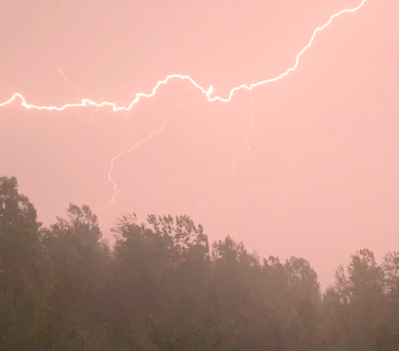 |
| Lightning over St. Albans, Vermont on June 21, 2021. Lightning activity was actually below normal in northern Vermont last year. |
Still, believe it or not, the number of lightning strikes in the U.S. last year was still a little below normal.
The report, with oodles of lightning information, comes from Vaisala, a company that, among other things, has state of the art technology to monitor lightning across the globe.
One disconcerting stat in Vaisala's report comes from the very high Arctic.
Above 80 degrees north, at the very top of the world, there were 7,278 lightning strikes in 2021. That's not many at all, compared to activity at lower latitudes (Little old Vermont had 71,264 lightning bolts in 2021 for instance).
But those 7,278 bolts in the high Arctic are something completely new. It was 91 percent more lightning than in the previous nine years combined.
In general, you need warm, humid air and moisture to get thunderstorms. Those two ingredients are normally pretty much completely lacking above 80 degrees north.
The high Arctic lightning in 2021 by far set a record for bolts up there. It's a sign that the Arctic is changing, and is no longer the Northern Hemisphere's icebox that it once was.
In the rest of the Arctic, between 65 and 80 degrees north, lightning hasn't increased by much in recent years.
Back in the United States, lightning activity in 2021 was above normal around the Great Lakes, central and southern New England, the Mid-Atlantic states and the Desert Southwest.
This tracks well with other weather stats that we saw in 2021. The Mid-Atlantic States, Great Lakes and southern New England had much more rain than normal, and more bouts with severe thunderstorms than usual.
The Desert Southwest had a busier than average monsoon season, when moisture gets drawn into the deserts to produce mid and late summer thunderstorm outbreaks.
Vaisala also breaks down lighting trends in each state. In Vermont, lightning activity was a little above average in central and southwestern Vermont, but decidedly below average north of Route 2 all the way to the Canadian border. As always, most of the lightning was during the summer.
This also tracks well with what we know about last summer's weather in Vermont. It was wetter than normal in southern Vermont, while drought gripped the north. Thunderstorms just avoided northern Vermont last year.
Vaisala can even tell you which town in each state had the greatest amount of lightning. In a supplemental report, Vaisala offers a list of towns and cities that are the lightning capitals of each state. Vermont's lightning capital was Ripton with 54 strikes per square mile.
The lightning capital of the United States was Flatonia, Texas, with 1,043 strikes.
As the Washington Post reports, the United States hit a record low for lightning deaths in 2021 with just 11, according to the National Lightning Safety Council. The year 2020 had just 17 lightning deaths, which was also well below average. In the past 15 years or so, between 25 and 45 people died annually from lightning strikes.
Better lightning awareness among the public and possibly more people not going outside during the pandemic might be responsible for the fewer number of deaths in 2021.

No comments:
Post a Comment